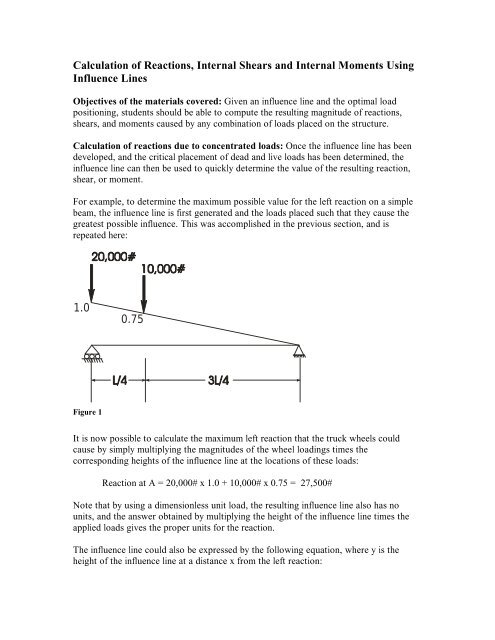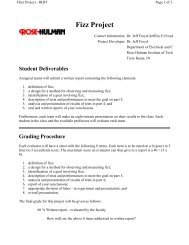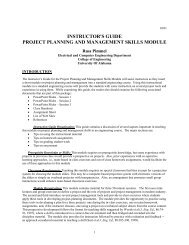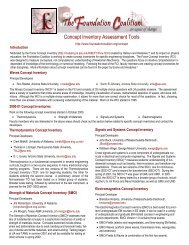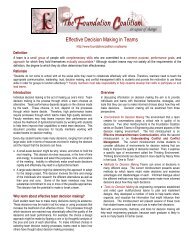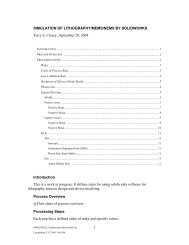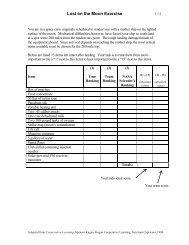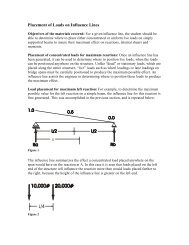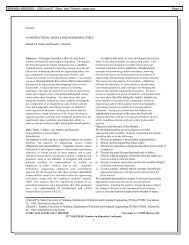Calculation of Reactions, Internal Shears and Internal Moments ...
Calculation of Reactions, Internal Shears and Internal Moments ...
Calculation of Reactions, Internal Shears and Internal Moments ...
You also want an ePaper? Increase the reach of your titles
YUMPU automatically turns print PDFs into web optimized ePapers that Google loves.
Thus the maximum possible reaction on a simply supported beam due to a uniformlydistributed load <strong>of</strong> any length can be determined using the influence line <strong>of</strong> Figure 1.First, the influence line tells us where to place the uniform load for maximum positiveeffect, namely across the entire length <strong>of</strong> the beam where the influence line is positive.WxNext, the value <strong>of</strong> the reaction can be computed by multiplying the magnitude <strong>of</strong> theuniform load w by the area under the influence line over which the uniform load isapplied:Ra = Height <strong>of</strong> uniform load * Area under the influence line triangleRa = w kips/ft * (L ft * (1.0+0)/2) = wL/2 kipsNow admittedly this result is rather obvious, <strong>and</strong> most people would not create aninfluence line for such a simple case. However, we will later show that determiningwhere to place these loads for maximum effect can be quite confusing unless influencelines are available.<strong>Calculation</strong> <strong>of</strong> maximum positive shear at a point in a beam: Previously we showedthe generation <strong>of</strong> an influence line for shear at the quarter point in a simply supportedoverhanging beam, with critical placement <strong>of</strong> a set <strong>of</strong> concentrated <strong>and</strong> uniform loads,which will be repeated here. Note that for maximum positive shear, the uniform live loadis placed only in the ranges where the influence line is positive.wL/4w0.250.750.250.50Assuming a uniform load <strong>of</strong> 2,000 pounds/foot, <strong>and</strong> L = 10 feet, we can calculate themaximum positive shear at the quarter point by:V ¼ positive =Concentrated Load*height + Concentrated Load*height+ Uniform Load*Area under diagram+ Uniform Load*Area under diagramV ¼ positive = 20k * 0.75 + 10k * (2/3)*0.75+ 2k/ft * 0.25 * (10ft/4)/2 + 2k/ft * 0.75 * (3*10ft/4)/2= 26.25 kips<strong>Calculation</strong> <strong>of</strong> maximum negative shear at a point in a beam: Previously we showedthe generation <strong>of</strong> an influence line for shear at the quarter point in a simply supported
M ¼ positive = Concentrated Load*height + Concentrated Load*height+ Uniform Load*Area under influence line+ Uniform Load*Area under influence line= 20kip * 0.1875*10ft + 10kip * 0.1875*10ft*2/3+ 2kip/ft * (0.1875*10ft*(10ft/2))= 406.25 kip ft<strong>Calculation</strong> <strong>of</strong> maximum negative moment at a point in a beam: Previously weshowed the generation <strong>of</strong> an influence line for moment at the quarter point in a simplysupported overhanging beam, with critical placement <strong>of</strong> a set <strong>of</strong> concentrated <strong>and</strong>uniform loads, which will be repeated here:wwAssuming a uniform load <strong>of</strong> 2,000 pounds/foot, <strong>and</strong> L = 10 feet, we can calculate themaximum negative moment at the quarter point by:M ¼ negative =Concentrated Load*height + Concentrated Load*height+ Uniform Load*Area under influence line+ Uniform Load*Area under influence line= 20kip * -0.375*10ft + 10kip * (-0.375*10ft)/2+ 2kip/ft * (-0.375*10ft * (10ft/2)/2)+ 2kip/ft * (-0.03125*10ft)*(10ft/8)/2= 131.64


